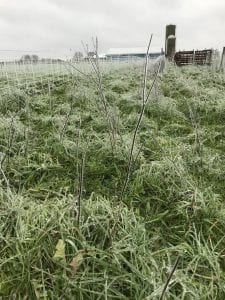Dorothy Perkins, Former Dairy, Livestock, and Forage Crops Field Specialist, University of New Hampshire
(Previously published online with the University of New Hampshire Extension, December 6, 2017)
Another summer gone and school has started. I’m thinking about adjusting my driving schedule to avoid buses, heat for the house, my winter garden, and preparing my animals and their winter digs for the long, cold days and nights ahead. It’s a New England thing, we spend the warm days preparing for the cold ones. Brrr.. it’s cold away from the wood-stove, but winter doesn’t mean you can neglect livestock care. Quite the contrary. Preparing now can make it much easier once the snow flies. Here are some basic things to consider.
summer gone and school has started. I’m thinking about adjusting my driving schedule to avoid buses, heat for the house, my winter garden, and preparing my animals and their winter digs for the long, cold days and nights ahead. It’s a New England thing, we spend the warm days preparing for the cold ones. Brrr.. it’s cold away from the wood-stove, but winter doesn’t mean you can neglect livestock care. Quite the contrary. Preparing now can make it much easier once the snow flies. Here are some basic things to consider.
Animals in a closed barn environment during the winter months will still need fresh air, which means good ventilation. A warm, tightly closed barn may seem comfortable to us, it’s not so for livestock. Good air exchange is important to eliminate ammonia gas that causes respiratory problems. It also lowers communicable diseases associated with a close contact environment. Alternatively, drafts should be avoided.
Living areas will need to be cleaned of manure and wet bedding routinely, depending on Continue reading Basic Winter Care for Livestock

 is a very stressful time for small ruminants. Proper management leading up to delivery can help to reduce complications.
is a very stressful time for small ruminants. Proper management leading up to delivery can help to reduce complications. snow, ice, and freezing temperatures are on the way. Winter can be a real struggle for two- or four-legged animals. Those of us with two legs can generally put on a warmer coat or go inside to warm up with a cup of something hot, but what can livestock managers do to keep animals healthy and comfortable in the upcoming winter? Being proactive about livestock’s winter needs will reap many more dividends than will responding to a problem after it has developed.
snow, ice, and freezing temperatures are on the way. Winter can be a real struggle for two- or four-legged animals. Those of us with two legs can generally put on a warmer coat or go inside to warm up with a cup of something hot, but what can livestock managers do to keep animals healthy and comfortable in the upcoming winter? Being proactive about livestock’s winter needs will reap many more dividends than will responding to a problem after it has developed. on what part of the state or country you live in, this year has been another challenge with pastures and forages. Hay yields are all over the board as far as quantity and to date I am surprised of the few results that I have seen the quality. Many in my area were able to get first cutting of in great time this spring, but the quality has been surprisingly lower than expected. So as many finish up hay making, now is a good time to take inventory of what you have and take forage samples to determine what nutrient values are in the crop.
on what part of the state or country you live in, this year has been another challenge with pastures and forages. Hay yields are all over the board as far as quantity and to date I am surprised of the few results that I have seen the quality. Many in my area were able to get first cutting of in great time this spring, but the quality has been surprisingly lower than expected. So as many finish up hay making, now is a good time to take inventory of what you have and take forage samples to determine what nutrient values are in the crop.


 offer an alternative to utilizing forage and vegetation which is otherwise “wasted,” while producing a healthful food product (meat) currently marketable and in demand by a growing segment of the US population. In addition, because of their preference for “browse” goats offer the potential for using idle land that is currently unproductive, and for biological control of unwanted vegetation in pastures and forests without use of pesticides.
offer an alternative to utilizing forage and vegetation which is otherwise “wasted,” while producing a healthful food product (meat) currently marketable and in demand by a growing segment of the US population. In addition, because of their preference for “browse” goats offer the potential for using idle land that is currently unproductive, and for biological control of unwanted vegetation in pastures and forests without use of pesticides.